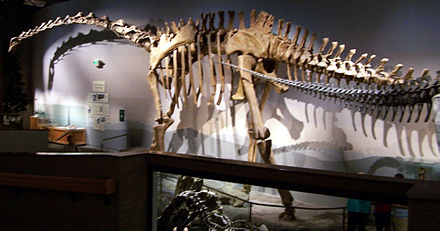Supersaurus
Supersaurus (meaning "super lizard") is a genus of diplodocid sauropod dinosaur that lived in North America during the Late Jurassic period. The type species, S. vivianae, was first discovered by Vivian Jones of Delta, Colorado, in the middle Morrison Formation of Colorado in 1972. The fossil remains came from the Brushy Basin Member of the formation, dating to about 153 million years ago.[1] A potential second species, S. lourinhanensis, (Dinheirosaurus) is known from Portugal and has been dated to a similar time.[2]
Supersaurus is among the largest dinosaurs known from good remains, possibly reaching 39–40 meters (128–131 ft) in length,[3] and a weight of 31.8–36.3 metric tons (35.1–40.0 short tons).[4]
The first described specimens of Supersaurus were individual bones that suggested a large diplodocid. A large cervical vertebra BYU 9024 from the same quarry was later assigned to Supersaurus.[5] This vertebra measures 1,380 millimeters (54 in) and is the longest cervical known.[6] This enormous vertebra was reclassified as a Barosaurus vertebra, by Mike Taylor and Matt Wedel.[7], however Brian Curtice assigned it to Supersaurus on the basis of additional specimens.[3]
The assignment of the more complete specimen, WDC DMJ-021, to Supersaurus suggests that in most respects it was very similar in anatomy to Apatosaurus but less robustly built with especially elongated cervical vertebrae, resulting in one of the longest known sauropod necks.[4]
The original fossil remains of Supersaurus were discovered in the Dry Mesa Quarry in 1972. This find yielded only a few bones: mainly the shoulder girdle, an ischium and tail vertebrae. Paleontologist James A. Jensen described Supersaurus; he designated a scapulocoracoid BYU 9025 (originally labeled as BYU 5500) as the type specimen. This shoulder girdle stood some 2.4 meters (8 ft) tall, if placed on end. The specimen was given the name "Supersaurus" informally as early as 1973,[8] but was not officially described and named until more than a decade later, in 1985.[9]
Sauropod researcher Jack McIntosh at one time thought that the BYU Supersaurus material might represent a large species of Barosaurus but later felt that there was evidence for Supersaurus being a valid genus.[10]




